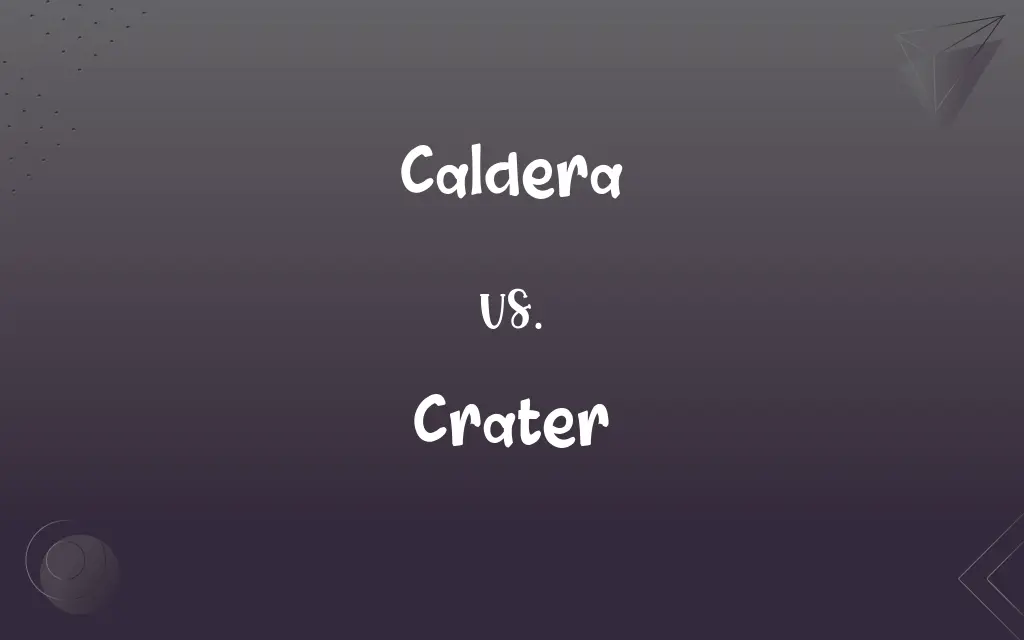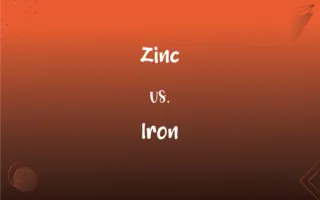Caldera vs. Crater: What's the Difference?
Edited by Aimie Carlson || By Janet White || Published on January 26, 2024
A caldera is a large, basin-like depression formed by the collapse of a volcano, while a crater is a smaller, circular depression, often at the summit of a volcano.

Key Differences
A caldera is formed when a volcano collapses into itself, creating a large, basin-like depression, often several kilometers in diameter. A crater, by contrast, is a smaller, typically circular depression, usually found at the summit of a volcano, formed by explosive volcanic activity.
Calderas are vast and can sometimes contain lakes or new volcanic cones within them. Craters are more clearly defined and are often characterized by a raised rim surrounding the depression.
Calderas are less common than craters and indicate a significant volcanic event, such as a major eruption or the emptying of a magma chamber. Craters are a more frequent occurrence on volcanoes and can be found on many volcanic peaks.
The formation of a caldera can significantly alter the surrounding landscape and indicate a change in volcanic activity. In contrast, the presence of a crater is a typical feature of many volcanoes and is integral to the ongoing volcanic process.
Both calderas and craters are significant geological features attracting tourists and researchers. Calderas, due to their size and unique ecosystems, can be central to tourism, while craters are often visited for their dramatic appearance and to observe volcanic activity.
ADVERTISEMENT
Comparison Chart
Size
Large, basin-like, several kilometers in diameter
Smaller, circular, confined to volcano summit
Formation
Collapse of a volcano or emptying of a magma chamber
Explosive volcanic activity
Characteristics
Can contain lakes, new volcanic cones
Defined by a raised rim, deeper depression
Frequency
Less common, indicates major volcanic events
More common, typical feature of volcanoes
Geological Impact
Alters landscape, changes in volcanic activity
Integral to ongoing volcanic processes
ADVERTISEMENT
Caldera and Crater Definitions
Caldera
A caldera can host new volcanic activity within its basin.
Inside the caldera, a new volcanic cone was slowly forming.
Crater
A crater is a circular depression at the summit of a volcano.
Smoke was rising from the crater of the active volcano.
Caldera
Calderas often form following a major volcanic eruption.
The eruption left behind a vast caldera visible from space.
Crater
Craters are often formed by explosive volcanic eruptions.
The recent eruption created a new crater on the mountain's peak.
Caldera
A caldera is a large depression formed by the collapse of a volcano.
The Yellowstone Caldera is one of the largest volcanic systems in North America.
Crater
A crater can be a site of ongoing volcanic activity.
The volcano's crater was closely monitored for signs of another eruption.
Caldera
Some calderas contain lakes formed from rainwater or melted snow.
The caldera was filled with a deep blue lake.
Crater
Some craters are tourist attractions due to their dramatic appearance.
Tourists hiked to the edge of the crater for a panoramic view.
Caldera
A caldera is a significant geological feature indicating past volcanic activity.
The island's caldera was a popular destination for geologists.
Crater
A crater is smaller than a caldera and more clearly defined.
The well-defined crater was easily distinguishable from the surrounding landscape.
Caldera
A large crater formed by volcanic explosion or by collapse of a volcanic cone.
Crater
A constellation in the Southern Hemisphere near Hydra and Corvus.
Caldera
(vulcanology) A large crater formed by collapse of the cone or edifice of a volcano.
Crater
A bowl-shaped depression created by the activity of a volcano or geyser.
Caldera
A large crater caused by the violent explosion of a volcano that collapses into a depression
FAQs
What is a caldera?
A caldera is a large depression formed when a volcano erupts and collapses.
Is a caldera the same as a crater?
No, a caldera is usually much larger than a crater and forms differently.
Can calderas be found underwater?
Yes, submarine calderas exist, formed by underwater volcanoes.
Can calderas be tourist attractions?
Yes, many calderas are tourist attractions due to their unique landscapes.
How does a caldera form?
It forms after the emptying of a magma chamber in a volcanic eruption, causing the ground above to collapse.
How is a crater formed?
It forms either by the explosion of a volcano or by the impact of a meteorite.
How big can calderas get?
They can span several kilometers in diameter; some are among the largest volcanic features on Earth.
Are calderas dangerous?
They can be, especially if they are part of an active volcanic system.
What is an example of a caldera?
Yellowstone Caldera in the United States is a well-known example.
Are all volcanoes capable of forming calderas?
Not all; it depends on the volcano's structure and the nature of its eruptions.
What is a crater?
A crater is a circular depression typically formed by volcanic activity or meteorite impact.
Can craters be found on other planets?
Yes, craters are common on many celestial bodies, including the Moon and Mars.
What is an impact crater?
An impact crater is formed by the collision of a meteorite, asteroid, or comet with the Earth or another celestial body.
Are craters always circular?
They are typically circular, but their shape can be altered by erosion or geological processes.
What is an example of a famous crater?
The Barringer Crater in Arizona, USA, is a famous impact crater.
Can calderas erupt?
Yes, calderas can have eruptive events, depending on their volcanic activity.
How large can a crater get?
Crater sizes vary widely, from a few meters to hundreds of kilometers in diameter.
Can craters have water?
Yes, some craters can hold water and form natural lakes.
Do craters exist under the sea?
Yes, there are many undersea craters formed by volcanic activity or impacts.
Are crater sites used for scientific research?
Yes, craters are important for geological and planetary science research.
About Author
Written by
Janet WhiteJanet White has been an esteemed writer and blogger for Difference Wiki. Holding a Master's degree in Science and Medical Journalism from the prestigious Boston University, she has consistently demonstrated her expertise and passion for her field. When she's not immersed in her work, Janet relishes her time exercising, delving into a good book, and cherishing moments with friends and family.
Edited by
Aimie CarlsonAimie Carlson, holding a master's degree in English literature, is a fervent English language enthusiast. She lends her writing talents to Difference Wiki, a prominent website that specializes in comparisons, offering readers insightful analyses that both captivate and inform.































































